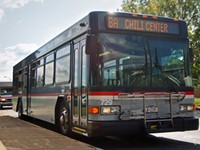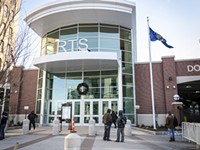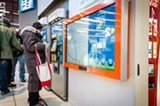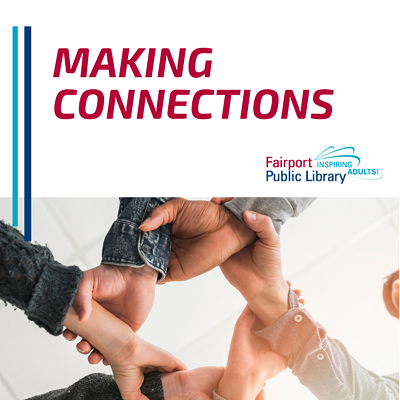[
{
"name": "500x250 Ad",
"insertPoint": "5",
"component": "15667920",
"parentWrapperClass": "",
"requiredCountToDisplay": "1"
}
]
Greater Rochester's public bus system is from another era, quite literally. It was originally designed when the city's downtown was a hub of offices, jobs, shopping, and services, and the buses were meant to move people between that core and its surrounding neighborhoods.
That means it was designed before Marketplace, Greece Ridge, or Eastview Malls; before the proliferation of office parks and corporate campuses in outlying suburbs; and before the city's population shrank by 100,000 people.
As Rochester's suburbs boomed, the bus system – RTS – had to adapt. Officials were left with "an impossible choice," say the folks at Reconnect Rochester, a transportation advocacy group.
They could expand service to the sprawling suburbs where the buses would reach fewer people, or they could maintain existing service for a decreasing urban population, says Reconnect Rochester. RGRTA – the Rochester Genesee Regional Transportation Authority, which runs RTS – tried to do both. The system left the urban riders who depend on the bus underserved and deterred others from using the service instead of their cars. Circuitous routes, the infrequency of bus arrivals, and long trip times are just some of reasons.
But RGRTA leaders recently started a process – dubbed Reimagine RTS – that could upend the current approach and ultimately lead to a more effective system. Reimagine RTS is an in-depth study of the system that will yield recommendations for near-future changes to the system, which could include a redesign of the routes. Right now, the agency is gathering data on who uses the system and how they use it, as well as soliciting input from the community at large.
"We need to have a significant dialogue with the community: How do we support what the community wants with the resources we have," says Bill Carpenter, RGRTA's chief executive officer.
But the project wasn't just spurred by the challenges facing RTS. Officials saw some opportunities, too. Young people, empty nesters, and seniors increasingly want more options for getting around without a car, and many are moving into urban areas looking for them, Carpenter says. (Although whether younger people truly want to live car-free lifestyles is currently a subject of great debate among researchers.)
In addition, over the past year or so, several new "mobility options," as Carpenter calls them, have come online in the Rochester area: Uber and Lyft, the Zagster bike share, and the city-initiated van pool program. RGRTA wants to find the best way to tie those systems in with the buses, Carpenter says.
He uses the van pool, which RGRTA is taking over and expanding, as an example of how that could work. Right now, two vans shuttle groups of 12 to 20 workers from their city neighborhoods to Del Lago casino in Seneca County and Pactiv Packaging in Canandaigua. The vans travel once daily to and from the workplaces, and each participant pays a monthly fee that's cheaper than a monthly bus pass.
Van pools are far cheaper to operate than buses, and they provide workers a better experience, Carpenter says. So if a handful of people need to get to places such as LiDestri Foods in Fairport or Rochester Tech Park in Gates, it may make more sense to set up a van pool to those sites instead of running bus lines there.
"Just because a bus doesn't go there doesn't mean a person can't get there," Carpenter says.
Reconnect Rochester has pushed for a bottom-up re-visioning of the local transit system since it was formed, says Mike Governale, the group's president. And it's praised RGRTA for opening up a once-in-a-lifetime opportunity to revamp the region's transit.
The group surveyed its members and developed its own lengthy list of recommendations for RGRTA to consider. Some of the items are simple, such as ensuring that bike racks are installed at well-used bus stops and providing information that event organizers can use in their promotional material to let people know which buses serve the site.
But Reconnect Rochester's top recommendations center on increasing bus frequency and consistency, both on weekdays and weekend. The group says buses should arrive every 30 minutes at minimum and every 15 minutes at key stops during peak hours.
"Frequency of service is really what gives people the freedom to be able to plan their lives around transit," Governale says. "It's not necessarily about how far out the transit lines go and the coverage and other things."
The group also recommends that RGRTA simplify routes so that they're more direct and avoid confusing zig-zags, twists, and turns. Routes should be designed so people can transfer between them at any point in the system, it says. And routes should be designed so people can travel from one section of the county to another without transferring at the downtown transit center, it says.
Governale acknowledges that some users may not agree with the recommendations. But RTS operates on a finite budget, and it's been clear that it wants to plan around what it has, not additional funding that it may or may not be able to secure down the road, he says.
"It's gotta be a balance," Governale says. "It's just the reality of how our community's been built and where the jobs have moved to and health services and things like that. We can't tilt the scale all to one end. There's going to have to be a balance we strike between coverage and frequency."
People with disabilities also have a big stake in this process as well as a separate but parallel update to RTS's paratransit plan. Under the Americans with Disability Act, RTS has to offer paratransit services anywhere it has bus routes.
Ericka Jones, a systems advocate at the Center for Disability Rights, says possible service cuts are one of the disability community's primary concerns, as is the lack of service in the suburbs. She recently spoke with a woman from Greece who tried to book a ride to church on a Sunday but couldn't, since RTS offers very limited paratransit service on weekends.
Many people with disabilities rely heavily on paratransit and the bus system in general to get to work, to go to the grocery store, and to meet friends, Jones says. Uber, Lyft, and taxis aren't a viable option for them since none of those services reliably accommodate people who use wheelchairs, rigid or motorized ones especially.
"We need more service across the board," Jones says. "The service is good; we just need more of it. We need more access to it."
Rochester People's Climate Coalition is also getting involved in the Reimagine RTS process. The group is focusing in on the transit system's potential to reduce greenhouse gas emissions, says Heather O'Donnell, who's on the leadership team of RPCC's newly formed transportation group.
The group is pushing for transit officials to be more aggressive in adding electric buses to the RTS fleet, O'Donnell says.
But the transit system's role in reducing carbon emissions, especially from the transportation sector, is much broader. O'Donnell says an effective transit system allows people to go more places by foot or bike; RTS buses already have racks that allow people to take their bikes with them. It could also, over time, affect land-use decisions, she says.
RGRTA's Carpenter echoes that last point. If decision-makers and residents start thinking about buses and all the other "mobility options" now at their disposal, development may become less car-centered and start moving closer to transit corridors, he says.
"Any kind of improvement to the mass transit system will be good for the environment: getting more people in buses, less people in cars," O'Donnell says. "But we also want to see that the improvements that are being made are environmentally conscious."
RGRTA plans to keep gathering input on public transit priorities and what the goals of Reimagine RTS should be through the end of this year. By January, it plans to begin talking with the public about the types of transit service people want, including the types of vehicles – buses, vans, etc. – that might serve different routes and how the RTS service could tie into options such as ridesharing. The agency expects to present its consultant's recommended route structures, again including the types of vehicles that would serve them, by the end of 2018.
From there, RGRTA will begin acting on the recommendations, whatever they may be.
Speaking of...
-

Rerouting of Rochester bus routes will be delayed
Mar 27, 2020 -

No cash? No problem soon for RTS bus riders
Jan 14, 2020 -

Board accepts transit redesign plan
Jun 27, 2019 - More »
Latest in News
More by Jeremy Moule
-

ROCHESTER TEN
ANNETTE RAMOSAug 1, 2023 - More »







